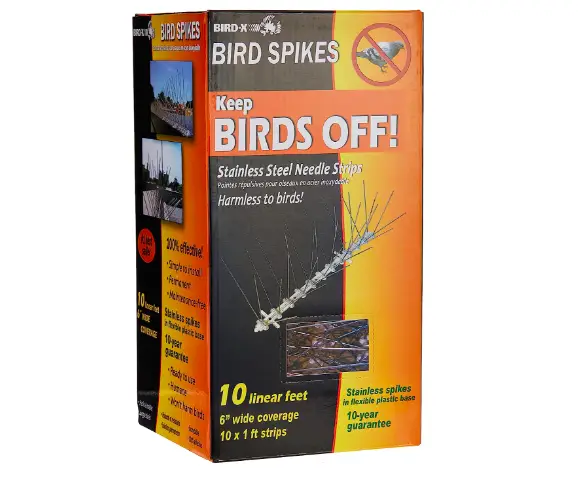Looking for tips on ‘how to get rid of crows on my lawn?’ You’ve come to the right place. Crows can damage your lawn as they look for insects to eat, leave behind unsightly droppings, and cause noise disturbances. If you’ve noticed crows visiting your lawn every so often, it’s advisable to take measures to protect your lawn from further damage. Creating a crow-free environment allows you to maintain the aesthetics and integrity of your outdoor space.
Here are 8 tips on how to get rid of crows on my lawn
1. Remove All Potential Sources of Crow Food
Crows are attracted to easily accessible food. Ensure that you don’t leave any food scraps or garbage uncovered outside. Ensure that your garbage cans have tightly fitted lids to prevent crows from rummaging through them. Similarly, secure compost bins to prevent access to food scraps that may attract crows.
If you have outdoor pets, avoid leaving their food out for extended periods. Feed them indoors or in designated areas, and promptly remove any leftover food to minimize attractants for crows.
Also, remove fallen seeds or grains. Crows are opportunistic feeders and will readily consume seeds or grains that have fallen from bird feeders, spilled from storage containers, or scattered across the ground. Regularly clean up any spilled birdseed or grains to reduce their food availability.
2. Install Motion-Activated Sprinklers
Installing motion-activated sprinklers is an effective method to deter crows from invading your lawn. Check out our Top 5 Motion-Activated Bird-Repellent Sprinklers for Effective Deterrence (Ranked and Reviewed, 2023). These sprinklers can startle the birds with a sudden burst of water, discouraging them from landing and causing any damage. Crows don’t like getting drenched and will steer clear of a property where they’re likely to get drenched with a surprise spray of water.
A motion-sensor sprinkler works by sprinkling water right towards any moving thing that it has detected through its motion sensor. Make sure you look for motion-activated sprinklers specifically designed for deterring pests. Identify the specific areas of your lawn where crows tend to congregate or cause the most trouble. These can include areas near bird feeders, trash cans, or places where you often spot them scavenging for food. Place them at a height where they can easily detect movement, usually around the average bird’s eye level.
3. Hang Shiny Objects Nearby
Most birds, including crows are not huge fans of shiny objects. Anything shiny or reflective affects their eyesight and may disorient them, so they will always steer clear of bright and shiny objects. Use this to your advantage and hang shiny objects like aluminum foil strips, old silverware, holographic flash tape, or CDs from trees, vines, and poles on your lawn.
Identify the areas where crows frequently gather or cause problems on your lawn. Hang the shiny objects in those locations, such as from tree branches, stakes, or even clotheslines. Ensure they are positioned in a way that allows them to catch the sunlight and create flashes of reflection. While at it, keep in mind that crows are intelligent birds and can quickly adapt to static objects. To maximize the effectiveness, periodically change the types and positions of the shiny objects. This variation will prevent the crows from getting accustomed to them, maintaining their effectiveness as deterrents.
4. Use Fake Predators Hang a Plastic Owl in Your Garden
Another tip on ‘how to get rid of crows on my lawn’ is to place fake predators in the vicinity to scare them away. You can strategically place fake predators like owl decoys, fake peregrine falcons, human decoys, or hawks to create a sense of threat for crows. You can also use a fake dead crow (hung upside down with its wings spread) for this purpose. Make sure you rotate their positions periodically to prevent crows from recognizing them as static objects.
5. Tend To Any Trees Where Crows Roost
Crows prefer tall trees with dense foliage, as it provides them with shelter and protection. If you regularly prune the branches of trees where crows tend to gather, the crows may relocate to somewhere else more hospitable. Taking care of their roosting spots can discourage crows from congregating in your area.
6. Plant deterrents
Crows dislike certain plants, such as marigolds, sunflowers, or roses. These plants emit scents or have characteristics that crows find unappealing, making them less likely to frequent the area. Consider incorporating these into your garden or lawn to discourage crows from landing.
7. Use Unpleasant Noises to Scare Unwanted Crows Away
Another idea on ‘how to get rid of crows on my lawn’ is to use noise deterrents. Crows are sensitive to sudden loud sounds and unfamiliar noises, which can make them uncomfortable and prompt them to seek quieter areas. But keep in mind that these noises can bother neighbors, so be considerate of those living nearby. Here are some sounds that can help keep crows away:
- Recorded crow calls that imitate a distressed crow
- Ringing sounds produced by wind chimes or bells
- Predator sounds
- Random loud noises like blasting cannons or fireworks
Place them strategically in the areas frequented by crows to startle and discourage them. As we’ve already mentioned, crows are smart creatures. It’s important to accompany these sounds with decoys. If crows hear recorded noises but then see no predator within the vicinity, they will eventually learn that the audio recording is fake and stay put.
8. Install Bird Spikes

If you have specific areas where crows gather, consider installing bird spikes to prevent them from landing. Bird spikes are sharp enough to prick crows, causing them to take off instantly. Be sure to install the spikes close enough, so that crows don’t find gaps to sneak through. These devices create an inhospitable surface that makes it difficult for crows to land and roost.
NOTE: Don’t Poison, Shoot, or Try To Capture Crows
It’s important to emphasize that when dealing with crows on your lawn, it’s crucial to resort to humane and non-lethal methods. Poisoning, shooting, or attempting to capture crows should never be considered viable solutions. Not only are these methods inhumane, but they may also be illegal and pose risks to other wildlife, pets, and even humans. It’s always best to focus on deterrents and strategies that encourage crows to find alternative spaces rather than cause them harm.
Conclusion
There you have it. These are the most effective tips for preventing crows from damaging your lawn. Crows are notoriously intelligent creatures, so you’ll need to stay many steps ahead of this bird if you want to truly deter them from visiting your lawn for good. If you’ve been searching for tips on’ how to get rid of crows on my lawn,’ we hope this guide will help.



